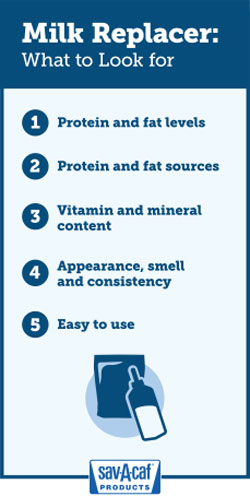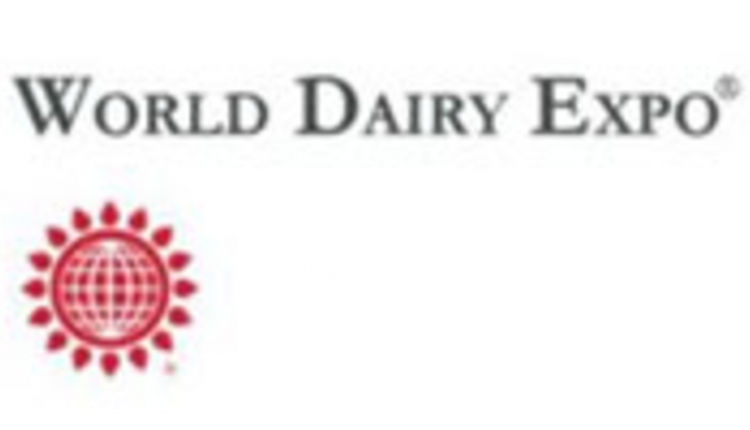The information below has been supplied by dairy marketers and other industry organizations. It has not been edited, verified or endorsed by Hoard’s Dairyman. 


You want what’s best for your calves, and a key to that is selecting a milk replacer to meet their needs. Quality nutrition helps calves feel happy and healthy and puts them on a path for a productive life.

Not all calf milk replacers are the same. Ingredient quality and nutritional value can vary widely between products. Understanding the differences will help you make the right choice for your calves rather than choosing solely on price and availability.
“Take time to understand differences between milk replacers so you can make an informed purchase,” advises Julian (Skip) Olson, DVM, technical services manager for Milk Products. “Give your calves a strong start by choosing a quality milk replacer like Sav-A-Caf® with a blend of energy, protein, vitamins and minerals. Your calves will grow and feel their best when fed a milk replacer that meets their needs.”
Here are five key considerations to keep in mind when picking a milk replacer:
1. Protein and fat levels
Crude protein and crude fat are the primary ingredients in milk replacer and represent the product’s formulation. For example, a 20:20 milk replacer contains 20 percent crude protein and 20 percent crude fat. Crude fat is a concentrated energy source offering 2.25 times the energy of carbohydrates while also providing essential fatty acids. Crude protein delivers essential amino acids calves require.
“Calves need plenty of protein and energy to grow,” notes Olson. “And in cold weather, their energy requirements increase. That is why it’s critical to feed a milk replacer comprised of an appropriate amount of protein and fat along with the required total solids to meet their needs in cold weather.”
A good guideline to follow is to choose a milk replacer containing a minimum of 20 percent protein and 20 percent fat.
2. Protein and fat sources
“Look for a milk replacer with highly digestible fat sources. Great fat sources include whole milk fat, lard, tallow and limited amounts of soy, palm or coconut oil,” says Olson. “Protein sources may include all-milk proteins or alternative proteins.”
Here’s a list of proteins proven acceptable for use in calf milk replacers.[1]
All-milk proteins:
- Dried whey protein concentrate
- Dried whey
- Dried whey product
- Skim milk
- Casein
- Sodium or calcium caseinate
Alternative proteins:
- Soy protein isolate
- Protein-modified soy flour
- Soy protein concentrate
- Animal plasma
- Wheat gluten or isolate
“You’ll want to avoid protein sources from meat solubles, fish protein concentrate and wheat flour, all of which can be harmful to calves,” says Olson. “Soy flour can be a useful source of protein when blended with milk proteins as a way to reduce milk replacer cost.”
However, Olson advises to use caution when feeding a milk replacer with soy flour.
“Younger calves do not tolerate soy flour. Wait until calves’ digestive system is more mature – around three weeks of age – before feeding a milk replacer with soy flour,” he says.
3. Vitamin and mineral content
“Just like children, calves need vitamins and minerals to grow properly and feel their best,” says Olson.
Vitamins A, D and E, as well as B-complex vitamins are essential to good health, growth and immune function.
“Calcium and phosphorus play big roles in bone development,” says Olson. “Milk replacer should contain between 0.75 and 1.25 percent calcium and at least 0.7 percent phosphorus.”
4. Appearance, smell and consistency
How the product looks, smells and mixes is also important. Dry milk replacer powder should be cream to light tan in color and free of lumps and foreign material.
“Powder that has ‘browned’ significantly suffers from reduced nutrient quality and flavor,” says Olson. “It is normal to see a very small amount of tiny brown specks from the milk powder drying process.”
“It should be bland to pleasant in aroma. If powder resembles the smell of paint, grass, clay or gasoline, the fat ingredients may be rancid.”
5. Easy to use
Choose a milk replacer with clear, easy-to-understand mixing instructions and step by step feeding directions.
“Feeding your calves should be a fun chore,” Olson says. “Clear, thorough instructions will help you feel confident you’re meeting your calves’ needs as they grow.”
Milk replacer is critical to provide calves the nutrients they need for a healthy, productive life. Choosing a milk replacer with the right nutrients, quality ingredients that mix into water easily and clear feeding instructions will help you choose the best milk replacer for your family’s calves.
For more information about calf care, visit savacaf.com, like My Farm Journey on Facebook and follow us on Instagram.
Milk Products, based in Chilton, Wis., manufacturers high-quality animal milk replacers and young animal health products. Using its innovative manufacturing technology, Milk Products produces over 700 unique animal nutrition products for numerous independent feed manufacturers, wholesale distributors, and large retail chains. Our customers choose whether these products are sold under their private label brand, or under the Sav-A-Caf® brand which is manufactured and marketed by Milk Products.


